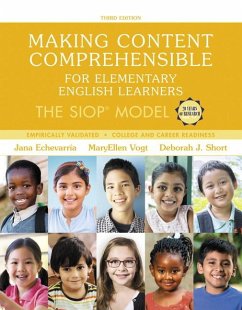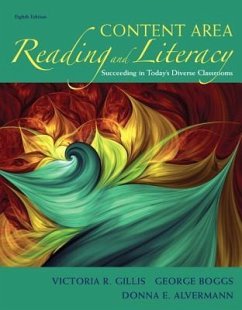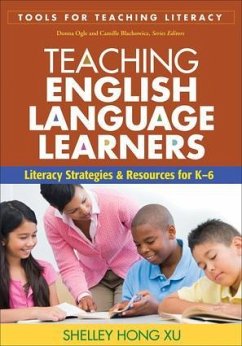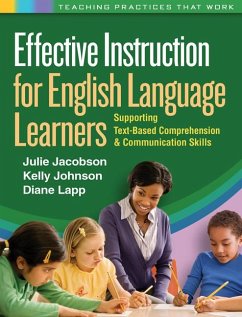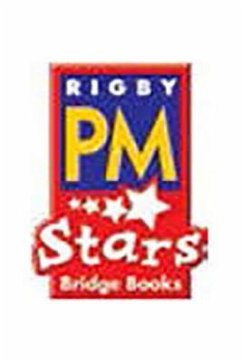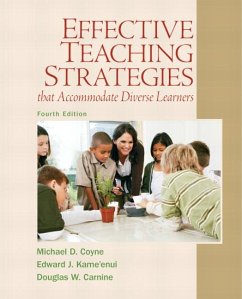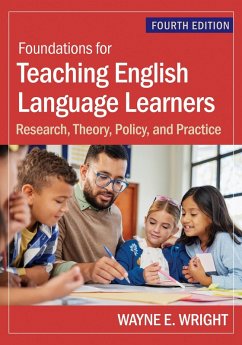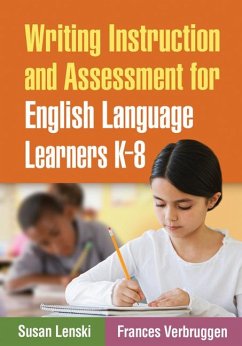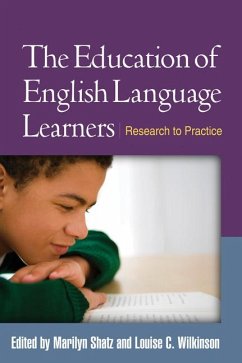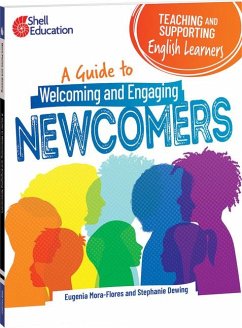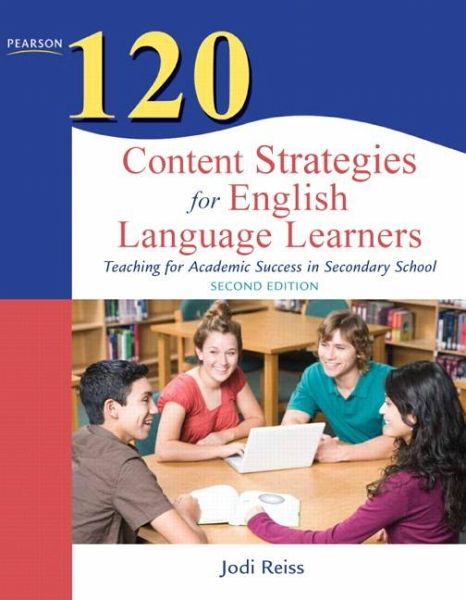
120 Content Strategies for English Language Learners
Teaching for Academic Success in Secondary School
Versandkostenfrei!
Versandfertig in über 4 Wochen
67,99 €
inkl. MwSt.

PAYBACK Punkte
34 °P sammeln!
Written by renowned author Jodi Reiss, 120 Content Area Strategies for Teaching English Language Learners offers practical instructional and assessment strategies built on a strong foundation of second language acquisition theories and principles that you can easily incorporate into your daily classroom instruction. The 120 strategies address all aspects of teaching your English language learners, from building background knowledge, through facilitating instruction, textbook comprehension, activities, and assignments, to assessing learning. All these strategies are concise and easy to follow with helpful guides to help you maximize your secondary students' performance potential in the content areas at every level of English language development.
New to this Edition:
15 new practical applications
Substantial additions in areas of reading the textbook, review techniques and products, and questioning techniques for increased participation
Expanded and updated TechConnection websites
Book Club section with questions for self-directed discussion
Chart of select strategies cross-referenced with core content areas in addition to previously included chart of strategies that support the four language skills
Product Description
Written by renowned author, Jodi Reiss, 120 Content Area Strategies for Teaching English Language learners offers practical instructional and assessment strategies built on a strong foundation of second language acquisition theories and principles that you can easily incorporate into your daily classroom instruction. These strategies address how to build background knowledge and learning strategies, read for comprehension, give clear instructions, assess learning, consider culture & its impact on learning, and more. All 120 strategies are concise and easy to follow with helpful guides to help you maximize your secondary students' performance potential in the content areas at every level of English language development.
New to this Edition:
15 new practical applications
Substantial additions in areas of reading the textbook, review techniques and products, and questioning techniques for increased participation
Expanded and updated TechConnection websites
Book Club section with questions for self-directed discussion
Chart of select strategies cross-referenced with core content areas in addition to previously included chart of strategies that support the four language skills
Features + Benefits
The TechConnection offering helpful websites.
Questions for Discussion section ending each chapter, helping students to review the Twelve Guidelines for Practice to select those that are foundational to the set of strategies that were the focus of that chapter
A Glossary listing acronyms relating to all aspects of English language development, including, but not limited to, those used in this book
The Book Club section follows with questions for self-directed group discussion
An Appendix containing additional teacher resources-books and websites that are excellent sources of valuable information for teaching content to English language learner
Backcover
Best-selling author Jodi Reiss presents teachers with practical instructional and assessment strategies built on a strong foundation of second language acquisition theories and principles. The 120 strategies address all aspects of teaching your English language learners, from building background knowledge, through facilitating instruction, textbook comprehension, activities, and assignments, to assessing learning. These concise and easy-to-follow strategies will help maximize your secondary students' performance potential in the content areas at every level of English language development.
This Second Edition of this favorite teacher resource now includes 18 new strategies and 15 new practical applications, as well as substantial additions in the areas of reading the textbook, review techniques and products, and questioning techniques for increased classroom participation. Reiss has expanded and updated the TechConnection feature, included a Book Club section with questions for self-directed discussion, and added a chart of select strategies cross-referenced with core content areas in addition to previously included chart of strategies that support the four language skills.
What are your colleagues saying about 120 Content Area Strategies for Teaching English Language Learners?
This user-friendly text can be used as a guide for new teachers who are looking to gain understanding of language and content learning as well as seasoned teachers who want to expand their repertoire of useful strategies.
Jennifer Stengel-Mohr, Queens College
I found this book to be an excellent guide for novices and veteran teachers alike. The ideas are written in clear and understandable language. The strategies and techniques are explained in a way that makes teachers comfortable enough to attempt them with confidence.
Timothy A. Rodriguez, The Ohio State University at Lima
About the Author
Jodi Reiss has taught students at every level of instruction. Before retiring from Florida International University in Miami, she served as the director of the TESOL Masters' program where she adapted, developed, and taught a variety of graduate and undergraduate TESOL courses. Since her retirement, Jodi has written three books for secondary school teachers on strategies for teaching content to English language learners. She conducts teacher workshops and presentations for school districts throughout the United States.
Contents
Foreword: Ten Questions
Preface
Part I Perspectives for Classroom Practice: Theory and Culture
Chapter 1 Theoretical Considerations
Why Content Teachers Can Help
How Content Teachers Can Help
Theoretical Foundations
Cummins: Differentiation of Social and Academic Language
Krashen: The Affective Filter
Krashen: The Comprehensible Input Hypothesis
Vygotsky: Zone of Proximal Development
Swain: Meaningful Output
Brown: Principles of Language Teaching and Learning
Bloom: Taxonomy
Applying the Theories and Principles
Theory to Application: Twelve Guidelines for Practice
Questions for Discussion
References and Resources
Chapter 2 Culture and Content Instruction
Culture and the Process of Content Instruction
Class Work Patterns
Instructional Patterns
Questioning Patterns
Expressing Opinions
Response Time Patterns
Attention Patterns
Feedback Patterns
Patterns of Address
A Shift in Perception
Cultural Behaviors Change Slowly
Culture and the Product of Content Learning
Special Considerations for Teachers of Math
Special Considerations for Teachers of Science
Special Considerations for Teachers of Social Studies
Special Considerations for Teachers of Language Arts, Reading, and Literature
Questions for Discussion
References and Resources
Part II Strategies for Classroom Practice: Instruction
Chapter 3 Meeting State Objectives and Standards: Making Good Choices
Standards for English Language Learners
The Dilemma of Standards
Selecting Standards, Topics, and Objectives
The Objective: Analyze Standards, Topics, and Objectives to Make Sound Choices
In Summary: Selecting Standards, Topics, and Objectives
Questions for Discussion
References and Resources
Chapter 4 Learning Strategies for English Language Learners
Learning Strategies Defined
Learning Strategies and Teaching Strategies: Same or Different?
Learning Strategies and Learning Styles: Same or Different?
The Types of Learning Strategies
Metacognitive Strategies
Cognitive Strategies
Memory Strategies
Social Strategies
Compensation Strategies
Working with Learning Strategies
The Objective: Combine Strategies and Strategy Types
The Objective: Actively Teach Learning Strategies
In Summary: Working with Learning Strategies
Questions for Discussion
References and Resources
Chapter 5 A Solid Start: Building and Activating Background Knowledge
Motivation
Preexisting Knowledge
All Students Need Background Knowledge
Working with Background Knowledge
The Objective: Use Varied Techniques to Activate and Build Background Knowledge
In Summary: Working with Background Knowledge
Questions for Discussion
References and Resources
Chapter 6 Presenting New Material: Teaching the Lesson
Oral Academic Language
The Difficulties of Oral Academic Language
Teacher Talk
The Objective: Pace Your Speech
The Objective: Simplify Your Speech
The Objective: Enhance Your Words
Classroom Routine and Review
The Objective: Create Classroom Routines
The Objective: Get into the Routine of Review
In Summary: Teaching the Lesson
Questions for Discussion
References and Resources
Chapter 7 Did They Get What I Taught? Checking Comprehension
Questions, Answers, and Participation in the Classroom
The Objective: Formulate Questions in Ways that Encourage Participation
The Objective: Fine Tune Your Awareness of Student Participation
In Summary: Classroom Questions, Answers, and Participation
Questions for Discussion
References and Resources
Chapter 8 Extending Comprehension: Textbook Vocabulary Strategies
New Vocabulary: Which Words to Teach?
Synonyms
Idioms
New Usages of Familiar Words
Just Plain New Words
Teaching and Learning Vocabulary
The Objective: Use Meaningful Strategies for Teaching and Learning Vocabulary
The Objective: Integrate Vocabulary Development into Daily Instruction
In Summary: Teaching and Learning Vocabulary
Questions for Discussion
References and Resources
Chapter 9 Extending Comprehension: Textbook Reading Strategies
Working with Your Textbook
The Objective: Show Students How to Get the Most Out of Their Textbooks
The Objective: Help Students Become Competent Note Takers
The Objective: Use Alternative Resources for True ELL Beginners
In Summary: Working with Your Textbook
Questions for Discussion
References and Resources
Chapter 10 Reinforcing Learning: Activities and Assignments
Assignments to Promote Student Success
The Objective: Good Assignments Begin with Good Directions
The Objective: Modify Whole Class Assignments to Make Language Comprehensible
The Objective: Differentiate Instructional Activities and Assignments
In Summary: Assignments that Promote Student Success
Questions for Discussion
References and Resources
Part III Strategies for Classroom Practice: Assessment
Chapter 11 Classroom Assessments: Did They Learn What You Taught?
Essay Questions, Multiple-Choice Questions, and Language Demand
The Pitfalls of Multiple-Choice Tests
Separating Language from Content in Assessments
The Objective: Modify Testing Techniques
The Objective: Don't Test at All!
The Objective: Grade Engl
New to this Edition:
15 new practical applications
Substantial additions in areas of reading the textbook, review techniques and products, and questioning techniques for increased participation
Expanded and updated TechConnection websites
Book Club section with questions for self-directed discussion
Chart of select strategies cross-referenced with core content areas in addition to previously included chart of strategies that support the four language skills
Product Description
Written by renowned author, Jodi Reiss, 120 Content Area Strategies for Teaching English Language learners offers practical instructional and assessment strategies built on a strong foundation of second language acquisition theories and principles that you can easily incorporate into your daily classroom instruction. These strategies address how to build background knowledge and learning strategies, read for comprehension, give clear instructions, assess learning, consider culture & its impact on learning, and more. All 120 strategies are concise and easy to follow with helpful guides to help you maximize your secondary students' performance potential in the content areas at every level of English language development.
New to this Edition:
15 new practical applications
Substantial additions in areas of reading the textbook, review techniques and products, and questioning techniques for increased participation
Expanded and updated TechConnection websites
Book Club section with questions for self-directed discussion
Chart of select strategies cross-referenced with core content areas in addition to previously included chart of strategies that support the four language skills
Features + Benefits
The TechConnection offering helpful websites.
Questions for Discussion section ending each chapter, helping students to review the Twelve Guidelines for Practice to select those that are foundational to the set of strategies that were the focus of that chapter
A Glossary listing acronyms relating to all aspects of English language development, including, but not limited to, those used in this book
The Book Club section follows with questions for self-directed group discussion
An Appendix containing additional teacher resources-books and websites that are excellent sources of valuable information for teaching content to English language learner
Backcover
Best-selling author Jodi Reiss presents teachers with practical instructional and assessment strategies built on a strong foundation of second language acquisition theories and principles. The 120 strategies address all aspects of teaching your English language learners, from building background knowledge, through facilitating instruction, textbook comprehension, activities, and assignments, to assessing learning. These concise and easy-to-follow strategies will help maximize your secondary students' performance potential in the content areas at every level of English language development.
This Second Edition of this favorite teacher resource now includes 18 new strategies and 15 new practical applications, as well as substantial additions in the areas of reading the textbook, review techniques and products, and questioning techniques for increased classroom participation. Reiss has expanded and updated the TechConnection feature, included a Book Club section with questions for self-directed discussion, and added a chart of select strategies cross-referenced with core content areas in addition to previously included chart of strategies that support the four language skills.
What are your colleagues saying about 120 Content Area Strategies for Teaching English Language Learners?
This user-friendly text can be used as a guide for new teachers who are looking to gain understanding of language and content learning as well as seasoned teachers who want to expand their repertoire of useful strategies.
Jennifer Stengel-Mohr, Queens College
I found this book to be an excellent guide for novices and veteran teachers alike. The ideas are written in clear and understandable language. The strategies and techniques are explained in a way that makes teachers comfortable enough to attempt them with confidence.
Timothy A. Rodriguez, The Ohio State University at Lima
About the Author
Jodi Reiss has taught students at every level of instruction. Before retiring from Florida International University in Miami, she served as the director of the TESOL Masters' program where she adapted, developed, and taught a variety of graduate and undergraduate TESOL courses. Since her retirement, Jodi has written three books for secondary school teachers on strategies for teaching content to English language learners. She conducts teacher workshops and presentations for school districts throughout the United States.
Contents
Foreword: Ten Questions
Preface
Part I Perspectives for Classroom Practice: Theory and Culture
Chapter 1 Theoretical Considerations
Why Content Teachers Can Help
How Content Teachers Can Help
Theoretical Foundations
Cummins: Differentiation of Social and Academic Language
Krashen: The Affective Filter
Krashen: The Comprehensible Input Hypothesis
Vygotsky: Zone of Proximal Development
Swain: Meaningful Output
Brown: Principles of Language Teaching and Learning
Bloom: Taxonomy
Applying the Theories and Principles
Theory to Application: Twelve Guidelines for Practice
Questions for Discussion
References and Resources
Chapter 2 Culture and Content Instruction
Culture and the Process of Content Instruction
Class Work Patterns
Instructional Patterns
Questioning Patterns
Expressing Opinions
Response Time Patterns
Attention Patterns
Feedback Patterns
Patterns of Address
A Shift in Perception
Cultural Behaviors Change Slowly
Culture and the Product of Content Learning
Special Considerations for Teachers of Math
Special Considerations for Teachers of Science
Special Considerations for Teachers of Social Studies
Special Considerations for Teachers of Language Arts, Reading, and Literature
Questions for Discussion
References and Resources
Part II Strategies for Classroom Practice: Instruction
Chapter 3 Meeting State Objectives and Standards: Making Good Choices
Standards for English Language Learners
The Dilemma of Standards
Selecting Standards, Topics, and Objectives
The Objective: Analyze Standards, Topics, and Objectives to Make Sound Choices
In Summary: Selecting Standards, Topics, and Objectives
Questions for Discussion
References and Resources
Chapter 4 Learning Strategies for English Language Learners
Learning Strategies Defined
Learning Strategies and Teaching Strategies: Same or Different?
Learning Strategies and Learning Styles: Same or Different?
The Types of Learning Strategies
Metacognitive Strategies
Cognitive Strategies
Memory Strategies
Social Strategies
Compensation Strategies
Working with Learning Strategies
The Objective: Combine Strategies and Strategy Types
The Objective: Actively Teach Learning Strategies
In Summary: Working with Learning Strategies
Questions for Discussion
References and Resources
Chapter 5 A Solid Start: Building and Activating Background Knowledge
Motivation
Preexisting Knowledge
All Students Need Background Knowledge
Working with Background Knowledge
The Objective: Use Varied Techniques to Activate and Build Background Knowledge
In Summary: Working with Background Knowledge
Questions for Discussion
References and Resources
Chapter 6 Presenting New Material: Teaching the Lesson
Oral Academic Language
The Difficulties of Oral Academic Language
Teacher Talk
The Objective: Pace Your Speech
The Objective: Simplify Your Speech
The Objective: Enhance Your Words
Classroom Routine and Review
The Objective: Create Classroom Routines
The Objective: Get into the Routine of Review
In Summary: Teaching the Lesson
Questions for Discussion
References and Resources
Chapter 7 Did They Get What I Taught? Checking Comprehension
Questions, Answers, and Participation in the Classroom
The Objective: Formulate Questions in Ways that Encourage Participation
The Objective: Fine Tune Your Awareness of Student Participation
In Summary: Classroom Questions, Answers, and Participation
Questions for Discussion
References and Resources
Chapter 8 Extending Comprehension: Textbook Vocabulary Strategies
New Vocabulary: Which Words to Teach?
Synonyms
Idioms
New Usages of Familiar Words
Just Plain New Words
Teaching and Learning Vocabulary
The Objective: Use Meaningful Strategies for Teaching and Learning Vocabulary
The Objective: Integrate Vocabulary Development into Daily Instruction
In Summary: Teaching and Learning Vocabulary
Questions for Discussion
References and Resources
Chapter 9 Extending Comprehension: Textbook Reading Strategies
Working with Your Textbook
The Objective: Show Students How to Get the Most Out of Their Textbooks
The Objective: Help Students Become Competent Note Takers
The Objective: Use Alternative Resources for True ELL Beginners
In Summary: Working with Your Textbook
Questions for Discussion
References and Resources
Chapter 10 Reinforcing Learning: Activities and Assignments
Assignments to Promote Student Success
The Objective: Good Assignments Begin with Good Directions
The Objective: Modify Whole Class Assignments to Make Language Comprehensible
The Objective: Differentiate Instructional Activities and Assignments
In Summary: Assignments that Promote Student Success
Questions for Discussion
References and Resources
Part III Strategies for Classroom Practice: Assessment
Chapter 11 Classroom Assessments: Did They Learn What You Taught?
Essay Questions, Multiple-Choice Questions, and Language Demand
The Pitfalls of Multiple-Choice Tests
Separating Language from Content in Assessments
The Objective: Modify Testing Techniques
The Objective: Don't Test at All!
The Objective: Grade Engl
Written by renowned author Jodi Reiss, 120 Content Area Strategies for Teaching English Language Learners offers practical instructional and assessment strategies built on a strong foundation of second-language-acquisition theories and principles that you can easily incorporate into your daily classroom instruction. The 120 strategies address all aspects of teaching your English Language Learners, from building background knowledge, through facilitating instruction, textbook comprehension, activities, and assignments, to assessing learning. All these strategies are concise and easy to follow with helpful guides to help you maximize your secondary students' performance potential in the content areas at every level of English-language development. New to this Edition: * 15 new practical applications * Substantial additions in areas of reading the textbook, review techniques and products, and questioning techniques for increased participation * Expanded and updated TechConnection websites * Book Club section with questions for self-directed discussion * Chart of select strategies cross-referenced with core content areas in addition to previously included chart of strategies that support the four language skills



